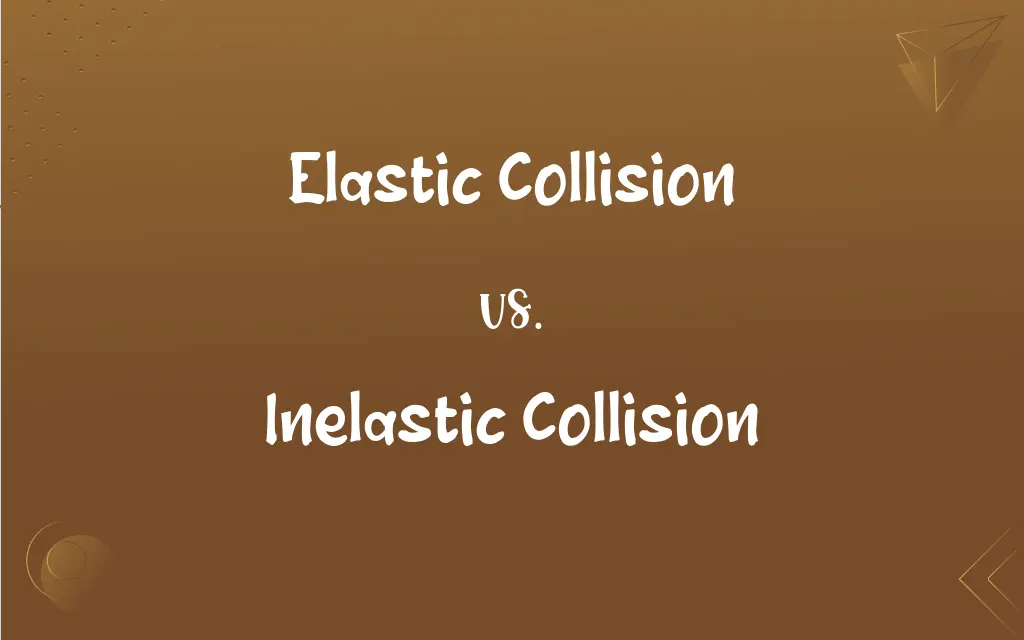Elastic Collision vs. Inelastic Collision: What's the Difference?
Edited by Aimie Carlson || By Harlon Moss || Updated on October 16, 2023
In an elastic collision, both momentum and kinetic energy are conserved; in an inelastic collision, only momentum is conserved.

Key Differences
In physics, when two objects collide, the nature of their interaction can be categorized as either an elastic collision or an inelastic collision. An elastic collision is one where both momentum and kinetic energy of the colliding system are conserved. On the other hand, an inelastic collision is characterized by the conservation of momentum, but not the kinetic energy.
During an elastic collision, the colliding objects bounce off each other without any loss of kinetic energy. However, in an inelastic collision, some kinetic energy is transformed into other forms of energy, often heat or potential energy, resulting in the objects not rebounding with the same kinetic energy they had prior to the collision.
Billiard balls hitting each other provide a good example of an almost elastic collision, where they bounce off with minimal energy loss. Conversely, a car crash exemplifies an inelastic collision, where the vehicles might stick together, and kinetic energy is lost as heat, sound, and deformation.
It's important to note that while total energy is always conserved (as per the law of conservation of energy), in an inelastic collision, not all this energy remains as kinetic energy. In contrast, elastic collisions maintain their kinetic energy post-collision, making them idealized situations often used in theoretical physics.
While perfectly elastic collisions are rare in the real world due to factors like air resistance and friction, they provide valuable theoretical models. In contrast, inelastic collisions are more commonly observed in day-to-day experiences, illustrating the reality of energy dissipation.
ADVERTISEMENT
Comparison Chart
Kinetic Energy Conservation
Conserved
Not conserved
Momentum Conservation
Conserved
Conserved
Post-collision Behavior
Objects bounce off each other
Objects may stick together or deform
Energy Transformation
None or minimal
Kinetic energy can turn into heat, sound, or deformation
Real-world Occurrence
Rare (ideal situations)
Common (e.g., car crashes)
ADVERTISEMENT
Elastic Collision and Inelastic Collision Definitions
Elastic Collision
Interaction where objects' velocities change while maintaining energy.
Even if directions change in an elastic collision, energy remains constant.
Inelastic Collision
Energy might transform into other forms.
In inelastic collisions, some kinetic energy can become heat.
Elastic Collision
Ideal interaction with no kinetic energy dissipation.
In an elastic collision, no energy is wasted as heat.
Inelastic Collision
Common real-world collision model.
Most daily observed collisions, like fruit dropping, are inelastic.
Elastic Collision
Collision conserving momentum and kinetic energy.
Billiard balls exhibit nearly elastic collisions.
Inelastic Collision
Collision where only momentum is conserved.
A car crash often results in an inelastic collision.
Elastic Collision
Objects rebound without energy loss.
Two rubber balls colliding demonstrate an elastic collision.
Inelastic Collision
Objects may stick together or deform.
Two cars colliding and crumpling demonstrate an inelastic collision.
Elastic Collision
Theoretical collision model in physics.
Elastic collisions are often used in physics problems for simplicity.
Inelastic Collision
Kinetic energy is not fully conserved post-collision.
Dough bouncing is less energetic after an inelastic collision.
FAQs
What's conserved in an elastic collision?
Both momentum and kinetic energy are conserved in an elastic collision.
Are perfectly elastic collisions common in real life?
Perfectly elastic collisions are rare in real life due to factors like friction.
Why are perfectly inelastic collisions called 'perfectly' if energy is lost?
The term "perfectly" refers to objects sticking together, not energy conservation.
Do objects stick together in an inelastic collision?
In some inelastic collisions, objects may stick together post-collision.
Can kinetic energy increase in an inelastic collision?
No, in an inelastic collision, kinetic energy can decrease but not increase.
What happens to the lost kinetic energy in an inelastic collision?
It can transform into other energy forms like heat or potential energy.
Can an elastic collision result in energy loss?
Theoretically, no; elastic collisions conserve both momentum and kinetic energy.
Are momentum and energy always conserved in collisions?
Total momentum is always conserved, but kinetic energy is only conserved in elastic collisions.
How do velocities change in an elastic collision?
Velocities change such that both momentum and kinetic energy are conserved.
Are there collisions that are neither perfectly elastic nor inelastic?
Yes, many real-world collisions fall somewhere in between the two extremes.
Why is a car crash typically inelastic?
Cars often deform or crumple, losing kinetic energy to deformation and heat.
Do inelastic collisions always produce heat?
Not always, but often some of the kinetic energy is transformed into heat.
What's a primary distinction between elastic and inelastic collisions?
The conservation of kinetic energy.
Can you have an inelastic collision without any deformation?
Yes, kinetic energy can be lost in other ways, like to sound or internal vibrations.
Is the total energy of a system conserved in inelastic collisions?
Yes, total energy is conserved, but not all remains as kinetic energy.
In an elastic collision, do objects always separate?
In an ideal elastic collision, objects bounce off each other post-collision.
Can two objects moving in the same direction have an elastic collision?
Yes, as long as momentum and kinetic energy are conserved.
Can objects change direction in an elastic collision?
Yes, objects can change direction but still conserve total kinetic energy.
What’s a common example of an almost elastic collision?
Billiard balls colliding.
Are all inelastic collisions involving sticking objects?
No, objects can bounce off in inelastic collisions but with kinetic energy loss.
About Author
Written by
Harlon MossHarlon is a seasoned quality moderator and accomplished content writer for Difference Wiki. An alumnus of the prestigious University of California, he earned his degree in Computer Science. Leveraging his academic background, Harlon brings a meticulous and informed perspective to his work, ensuring content accuracy and excellence.
Edited by
Aimie CarlsonAimie Carlson, holding a master's degree in English literature, is a fervent English language enthusiast. She lends her writing talents to Difference Wiki, a prominent website that specializes in comparisons, offering readers insightful analyses that both captivate and inform.
































































